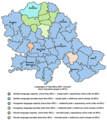Hungarian Regional Autonomy
This article has multiple issues. Please help improve it or discuss these issues on the talk page. (Learn how and when to remove these messages)
|

The Hungarian Regional Autonomy (Template:Lang-hu) is the name of a proposed new administrative unit in the northern part of the Autonomous Province of Vojvodina, Serbia, which is a part of the political program of the Alliance of Vojvodina Hungarians; but the idea is also supported by several other ethnic Hungarian political parties in Serbia.
Proposal
The creation of this new administrative unit was proposed by the Alliance of Vojvodina Hungarians political party. In this proposal, the Hungarian Regional Autonomy is proposed to be an autonomous region in the northern part of Vojvodina including the nine municipalities of northern Vojvodina: Subotica, Bačka Topola, Mali Iđoš, Kanjiža, Senta, Ada, Bečej, Čoka, and Novi Kneževac. The administrative centre of the region would be Subotica, while the region itself would be part of Vojvodina within Serbia. The proposal for the creation of the Hungarian Regional Autonomy is based on the autonomy model of South Tyrol in Italy.
Besides the Alliance of Vojvodina Hungarians and its coalition partners from Hungarian Coalition, some other ethnic Hungarian political parties and movements, like Hungarian Civic Alliance and 64 Counties Movement also advocating territorial autonomy for ethnic Hungarians in Vojvodina and Serbia.
Some variants of these proposals advocating that only 8 municipalities should be included into Hungarian autonomous region, excluding the municipality of Novi Kneževac, which have a Serb ethnic majority. Contrary to this, the proposal of the 64 Counties Movement advocates creation of Hungarian autonomous region in much larger territory, which would include not only municipalities with Hungarian majority or plurality, but also sizable neighboring areas, where several notable towns with Serb ethnic majority are located.
Demographics
According to the 2011 census data, the proposed new region would have a population composed of 49.6% Hungarians, 26.9% Serbs, 4.8% Croats, 4.4% Bunjevci, 2.2% Romani, and others.[1]
Some 61.1% of all Hungarians living in Serbia and 61.8% of all Hungarians living in Vojvodina would live within the borders of the proposed region.
The municipalities with Hungarian ethnic majority are: Kanjiža (85.1%), Senta (79.1%), Ada (75%), Bačka Topola (58%), Mali Iđoš (53.9%). Hungarians make plurality of the population in Čoka (49.6%).
The Novi Kneževac municipality has a Serb ethnic majority (57.2%).
The municipalities of Subotica, Bečej and Čoka are ethnically mixed. The population of Subotica municipality is composed of 35.6% Hungarians, 27% Serbs, 10% Croats, 9.5% Bunjevci, etc. The population of Bečej municipality is composed of 46.3% Hungarians, 41.3% Serbs, 2.2% Roma, etc. The population of Čoka municipality is composed of 49.6% Hungarians, 38.9% Serbs, 3.8% Roma, etc.
-
Ethnic map of Vojvodina (2011 census)
-
Language map of Vojvodina (2011 census)
-
Percentage of Hungarians in municipalities of Vojvodina (2011 census)
Controversy
This article possibly contains original research. (July 2009) |
The creation of the Hungarian Regional Autonomy with proposed regional borders is a controversial issue. If the new region is supposed to be created by the democratic consensus and free voluntary association of the municipalities or settlements, it is not likely that the citizens of the predominantly Serb municipality of Novi Kneževac would vote to join their municipality to the Hungarian Regional Autonomy.
It is also questionable how would react the majority of the citizens of the ethnically mixed municipalities of Subotica, Bečej, and Čoka since the ethnic Hungarians make up less than 50% of population in these municipalities. For example, in the municipality of Subotica, the proposed administrative center of the new region, only 35.6% of the population are ethnic Hungarians, while 53.3% of the population are various Serbian or Croatian speaking South Slavic ethnic groups.
Another problem regarding successful implementation of the regional autonomy proposal is demographic trend in the area. According to the 1991 census, ethnic Hungarians constituted 56.4% of the total population of the area while ethnic Serbs stood at 18.8%. However, these demographic relations have been changing ever since. In 2011, Hungarians no more form absolute majority of the population in the proposed region since they fell below 50% benchmark and now constitute 49.6% of the population while ethnic Serbs have risen to 26.9%. Differences in the last two decades show decrease of Hungarian and increase of Serb population in the area. If same demographic trends continue in the following time period, in the period around 2031 Serbs might replace Hungarians as the largest ethnic group in the area, hence it is hard to believe the majority of local inhabitants who will live in this area around that time would support regional autonomy proposal. There is also a question whether regional autonomy that would be established right now could prevent decline of Hungarian population in the area. The examples from municipalities such are Subotica or Bečej show that no matter that these municipalities were under ethnic Hungarian local administration, the number of Hungarians in these areas declined.
Support for the idea
In the 2016 local elections, the Alliance of Vojvodina Hungarians won the largest number of seats in the municipal parliaments of Subotica, Kanjiža, Senta, Bačka Topola, Mali Iđoš, and Čoka. Serbian Progressive Party won more votes than the Alliance of Vojvodina Hungarians in Bečej, in which relative majority of population is of Hungarian ethnicity.[2]
See also
References
- ^ "Archived copy" (PDF). Archived from the original (PDF) on 2014-08-11. Retrieved 2015-06-02.
{{cite web}}: Unknown parameter|deadurl=ignored (|url-status=suggested) (help)CS1 maint: archived copy as title (link) - ^ http://www.mojnovisad.com/vesti/kompletni-rezultati-lokalnih-izbora-u-vojvodini-id9213.html
External links
- Savez vojvođanskih Mađara (in Serbian)
- Vajdasági Magyar Szövetség (in Hungarian)



